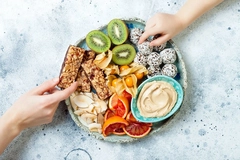Bakery ingredient innovation: Health and wellness, affordability and food waste mitigation
01 May 2024 --- The wellness megatrend is inspiring bakery ingredient innovation as consumers seek out nutritious but indulgent choices that support human and planetary health and satisfy diverse dietary requirements. Simultaneously, bakeries are increasingly demanding cost-effective solutions that elevate product formulations amid fluctuating ingredient costs and supply shortages.
In this report, we unpack the key trends driving the bakery ingredient market with leading suppliers CP Kelco, Puratos and International Flavors & Fragrances (IFF).
Innova Market Insights data suggests that global bakery product launches dipped during the COVID-19 pandemic but started to recover, registering a fractional (1%) average annual growth from 2019–2023.
Sweet Biscuits/Cookies held the top share (32%) in bakery product launches over this period, followed by Cakes (22%) and Bakery Ingredients & Mixes (18%).

“Vegetarian” (14%) was the top claim in bakery launches, followed by free-from claims. Various health claims gained traction in the category, notably “joint health” (+50%), while plant-based offerings grew 28%.
What consumers want
Health and wellness affects all F&B sectors, but within baked goods, “an emphasis on clean label ingredients and shorter ingredient lists, without compromising indulgent qualities” is the main focus, Elise Keddam, senior product manager for Citrus Fiber Marketing at CP Kelco, tells Food Ingredients First.
Another critical trend Keddam highlights is inclusivity, as bakeries target a broader and more diverse consumer base, including those with specific dietary requirements such as gluten-free, vegan, kosher and halal.
CP Kelco’s Nutrava Citrus Fiber is upcycled from citrus peels — a byproduct of the juice industry. It boosts dietary fiber intake and can be listed as simply “citrus fiber” on the label. It also supports gluten-free formulations, fat reduction and egg replacement in baked goods without compromising the sensory characteristics of a structured crust.
This week, CP Kelco completed a US$60 million expansion in production capacity for its citrus fiber product line.
The company also offers Keltrol Xanthan Gum — a fermentation-derived ingredient for gluten-free baking. It adds elasticity, helps bind ingredients and locks in moisture so baked goods hold their shape and will not dry out quickly.
Puratos has also found that consumers increasingly want baked goods that are healthy and tasty. Notably, the firm’s Taste Tomorrow survey has seen a rise in the popularity of sourdough, seeds and whole grains, with over half of consumers perceiving them as healthy (55%) and tasty (77%).
The Puratos Softgrain range is a blend of seeds and grains, soaked in sourdough to help meet the demand for tasty and healthy breads. Soaking the seeds and grains in sourdough helps deliver more taste and a soft-chewy texture and brings health benefits like increased fiber. Nutrava Citrus Fiber is upcycled from citrus peels and boosts dietary fiber intake (Image credit: CP Kelco).
Nutrava Citrus Fiber is upcycled from citrus peels and boosts dietary fiber intake (Image credit: CP Kelco).
“The same trend can be seen influencing sweet bakery, putting naturally sweet ingredients like fruit and vegetables in the spotlight,” Philippa Knight, marketing director at Puratos, tells us.
The company’s Utterly Fruity ingredients range enhances taste and texture while adding more fruit or vegetable content to baked goods.
“These ingredients also respond to the trend toward local sourcing and supply chain transparency, as the apples are grown just a few hundred meters from our fruit processing facility in Kent in the UK,” adds Knight.
Baking on a budget
There is also a growing demand for more cost-effective bakery ingredients that can help producers manage inflationary pressures and supply chain issues and enable consumers to overcome the ongoing cost-of-living crisis.
“While the situation has slightly improved in recent months with more stable wheat and energy prices, bakery producers must still navigate tight margins and cash flow issues caused by other variables,” Vanessa Bergamini Mendes, global product category marketing manager – Food Enzymes Bakery at IFF, tells Food Ingredients First.
“From raw material choice to addressing production challenges and waste, maximizing production and cost efficiencies is key to the current market dynamic.”
“But it is possible to overcome these challenges without sacrificing premium, better-for-you and label-friendly features by optimizing costs and improving the shelf life of baked goods.”
Bakers can reduce the impact of fluctuating ingredient costs or supply shortages by working with enzymes to improve flour quality, substituting the need for more expensive or scarce ingredients. By strengthening the gluten network, enzymes can reduce the need for vital wheat gluten additions, optimizing production costs while maintaining yield and overall bread quality.
“In Europe, some of the latest innovations focus on enzyme dough strengtheners designed for bakery manufacturers interested in vital gluten reduction, particularly in challenging applications such as whole wheat bread. These breakthrough enzymatic innovations allow operational cost reductions without compromising quality or volume trade-offs,” explains Mendes.
Enzymes can also deliver the appealing fine crumb and emulsification properties traditionally provided by more price-sensitive mono and diglycerides. Advanced enzymes can improve flour quality and mitigate the impact of fluctuating ingredient prices (Image credit: IFF).
Advanced enzymes can improve flour quality and mitigate the impact of fluctuating ingredient prices (Image credit: IFF).
Puratos’s enzyme-based solutions, like Intens Egg Replacer and Acti Egg, can reduce reliance on eggs — an ingredient often fluctuating in price.
Likewise, CP Kelco’s multifunctional and nature-based ingredients can help formulators reduce reliance on other ingredients that may be supply-challenged or prone to inflation.
Fighting food waste
Bread is one of the highest food waste categories globally. Food waste is a crucial challenge across the bakery sector as the degradation process of baked goods starts the moment products come out of the oven. Ensuring baked goods stay fresher longer is crucial for companies striving to meet their sustainability commitments and protect the bottom line.
“Creating the perfect tortilla, for example, means making it soft and flexible so that it can be rolled or folded without cracking throughout its shelf life,” says Mendes at IFF.
“Using enzyme solutions can help to keep tortillas and flatbreads fresh for significantly longer periods and ensure a reliable and robust baking process, which means less product is discarded, increasing profit margins in a hugely competitive sector.”
Similarly, CP Kelco’s Nutrava Citrus Fiber can help extend the shelf life of baked goods and reduce waste.
“The product is the first Upcycled Certified citrus fiber on the market, and we are committed to achieving a near wasteless lifecycle. Leftovers from our citrus peel process are repurposed,” explains Keddam.
“Nutrients in the process water are used to fertilize local crops, such as sugar cane, while leftover peels are turned into animal feed to help nearby farmers in the community near our manufacturing site in Brazil.”
Meanwhile, Puratos has increasingly turned to Life Cycle Assessments (LCAs) to support its environmental sustainability claims. Utterly Fruity ingredients enhance taste and texture while adding more fruit or vegetable content to baked goods (Image credit: Puratos).
Utterly Fruity ingredients enhance taste and texture while adding more fruit or vegetable content to baked goods (Image credit: Puratos).
“By analyzing the environmental impact of our products, we can aid our customers in accelerating their sustainability goals. LCAs measure the environmental impact of a product from sourcing raw materials to end-of-life disposal,” says Knight.
“We have conducted LCAs on Sunset Glaze, our plant-based egg wash alternative, our Belcolade plant-based chocolates and Mimetic, our plant-based butter alternative. Using the Product Environmental Footprint methodology, we discovered that Mimetic has lower CO2 and methane emissions, making its environmental impact almost three times lower than that of dairy butter.”
The company has also launched a product made with regeneratively farmed flour to boost bread’s sustainability credentials.
Looking forward
According to IFF’s proprietary trend intelligence tool, Panoptic Framework, “budget consciousness” will continue to be a key trend for consumers and manufacturers in the coming years.
“However, there are still plenty of opportunities ahead to innovate based on sustainability, simplicity, convenience and health and nutrition trends,” Mendes tells us.
“But innovation will need to ensure that products provide a sensorial experience to keep consumers coming back for more.”
By Joshua Poole












